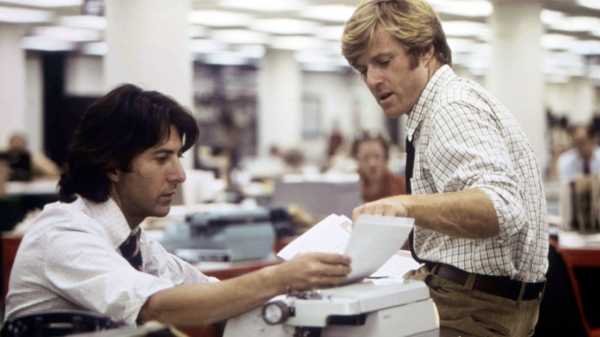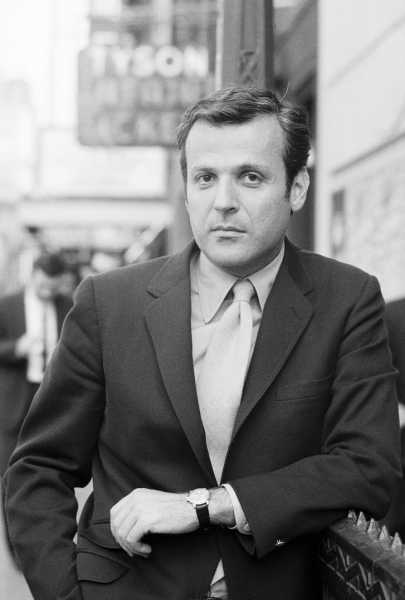
William Goldman, who died a week ago, had already written three Robert Redford movies when the actor contacted him in early winter of 1974 and asked him to write a fourth: an adaptation of Carl Bernstein and Bob Woodward’s forthcoming book, a firsthand account of the two young Washington Post reporters’ Pulitzer Prize-winning investigation of the Watergate scandal. Redford was the one doing the asking because he was producing the movie under the aegis of his company, Wildwood Enterprises—Redford was among the first wave of post-studio-system, post-auteur-movement movie stars who, in the late nineteen-sixties and early nineteen-seventies, began taking direct control of their careers, forming companies that would choose projects; select co-stars, directors, and writers; and participate in the casting, writing, and promotion of their movies. But Redford’s involvement in “All the President’s Men” was unusually complex and deep, predating not just Goldman’s involvement but also the conception of the book itself. By most accounts, Redford is a big reason why the book—which launched Bob Woodward’s iconic career as the first modern “star” reporter and permanently changed the public’s understanding of journalism—assumed its innovative form, focussing on the reporters and the Post rather than Nixon and the White House. But it was Goldman, in the crowning achievement of his long, successful career as a novelist and screenwriter, who used his screenplay to forge the modern myth of the reporter as hero.
The Watergate investigation was still ongoing, in 1972, when Woodward received a surprise phone call from Redford. “He was interested in the personal story of trying to figure out what happened, and our quest,” Woodward recalled, in a 2006 documentary about the making of the film. Dick Snyder, of Simon & Schuster, had purchased the book rights to the reporters’ story through the agent David Obst. The blockbuster fifty-five-thousand-dollar deal, as Michael Korda, the former editor-in-chief of Simon & Schuster, wrote in his memoir, “transformed [nonfiction] book publishing into a red-hot part of media.” Redford, according to most accounts, influenced the crucial decision to focus the narrative on the reporters themselves. “When we sat down to write a book, the book that we started to write was not about us; it was about Watergate,” Bernstein said. “Woodward came up to me one day and said he’d gotten a call from Redford, and I said, ‘What the hell about?’ And he said, well, he thinks the story is really us.”

William Goldman wrote the screenplay for “All the President’s Men.”
Photograph from Bettmann / Getty
The New Journalism movement of the nineteen-sixties and nineteen-seventies, spearheaded by Truman Capote, Norman Mailer, Tom Wolfe, Gay Talese, and others, had famously contrived an effective presentational style around obscuring the journalist. These narratives allowed readers to “witness” reported events, as if reading a novel, controversially blurring the line between fiction and reporting. (“The crucial part that reporting plays in all story-telling, whether in novels, films, or non-fiction, is something that is not so much ignored as simply not comprehended,” Wolfe wrote, in 1972.) The journalist is made to disappear: Wolfe’s scenic descriptions famously included a “man in a white suit,” who readers inferred was Wolfe, but that was the extent of the reporter’s visibility. “All the President’s Men” inverts this completely. The opening paragraph, which reads like Chandler or Hammett, makes clear where the focus will be:
June 17, 1972. Nine o’clock Saturday morning. Early for the telephone. Woodward fumbled for the receiver and snapped awake. The city editor of the Washington Post was on the line. Five men had been arrested earlier that morning in a burglary at Democratic headquarters, carrying photographic equipment and electronic gear. Could he come in?
Redford had very precise—and very cinematic—ideas about how the story should be told and why the reporters’ identities and character were important. “One guy was a Wasp; the other guy was a Jew. One guy was a Republican; the other guy was a radical liberal. They didn’t really care for each other, but they had to work together. And I thought, that dynamic is character-driven, and I liked that,” Redford said. Goldman agreed, and, once he had committed to adapting the book, spent hours with Woodward and Bernstein, trying to understand how best to transform them into movie characters. “Woodward was a fabulous help to me,” Goldman said. “What was tricky was trying to make the story hold. . . . This was just two guys plodding along. The whole movie was risky; nobody had any idea the movie would work.” But despite the temptation to glamorize the story, Goldman insisted on trying to be accurate. “I was terrified because you knew that everybody who was going to talk about this film had, at one time or another, been in a newsroom. Every power on television—they all began in newsrooms. And we knew if we Hollywood-ed it up, we would be in terrible trouble,” he said.
But “Hollywood-ing it up” became inevitable when Warner Bros., protecting their investment in the property, demanded that Redford appear in the movie, something the actor insists—perhaps protesting too much—that he had never intended to do. Redford had to bridge the gap between his own persona and Woodward’s affect, which was very different. “On the surface, Bob appeared to be just perfect. You just knew his lawn was cut. And there was really careful, slower speech, well thought out, very humble, very polite,” Redford said. “Finally, what I came to the conclusion of was that he was a man of just sheer hard work, he was obsessed with hard work, but the exterior of him, which probably came from his Midwest background and being a Republican, by party, might hide some other thing. . . . And what I concluded was that the thing that was submerged was a killer instinct. He would not let Bernstein get ahead with an assumption, and that was tension. But that was also Woodward’s way of making sure that when you got down to the moment, he could put the knife in, in the right way.”
Touchstones
New Yorker writers reflect on their favorite works of art.
Photographs by the former Look magazine photographer Stanley Tretick, collected in a glossy, now out-of-print book called “A Portrait of All the President’s Men” (published by Warner Books as a tie-in to the movie’s release, with text by the journeyman Hollywood publicist Jack Hirshberg) show Redford and Goldman in repeated meetings and newsroom visits with the reporters and the Post executive editor Ben Bradlee (played in the movie by Jason Robards, who won an Oscar); Redford is pictured studying Woodward’s movements and behavior while Woodward works at his desk. The twenty-nine-year-old Woodward, who was the lowest-paid person on the Post staff when the Watergate story broke, was nonplussed at being portrayed onscreen by Hollywood’s reigning sex symbol. “I’m essentially boring,” he said. “The way I live and work is undramatic. I’m not the sort of character you ordinarily see in the movies. I think it took tremendous guts on Redford’s part to play me.” It was Goldman who had to perform the essential act of alchemy, from journalism to cinema, by reinventing the reporters as movie heroes.
Goldman’s first project with Redford—George Roy Hill’s smash hit “Butch Cassidy and the Sundance Kid,” in 1969, in which Redford and Paul Newman portray the real-life Old West outlaw duo—had already laid the groundwork for connecting Redford, and his elusive, compelling California-golden-boy persona, with history and reality. (“Most of what follows is true” a title card announces as that movie begins.) “Cassidy”—which, in the words of the critic Pauline Kael, “put Redford right over the top,” cementing his superstardom—was, according to Kael, “a facetious Western.” It reversed the nihilistic trend (best embodied by Sergio Leone’s dark, violent spaghetti Westerns starring Clint Eastwood) that had, as Kael put it, “stripped the Western form of its cultural burden of morality.” Goldman put the morality back in, along with the charm, allowing Newman and Redford to play, essentially, themselves. Redford’s cowboy image was reinforced by his appearance in Sydney Pollack’s “Jeremiah Johnson,” in 1972, and by his purchase, in 1969, of land in Utah on which he established the Sundance resort, and, later, the Sundance Institute and its film festival.
In “All the President’s Men,” Redford’s cowboy-movie-star image peeks through the buttoned-down façade of his Bob Woodward like Superman’s costume emerging from within Clark Kent’s mild-mannered-reporter guise: beneath the button-down shirts, he sports Western jewelry and Redford’s left-handed Rolex. (Dustin Hoffman, who plays Carl Bernstein, came from the New York school of method acting, and wears Bernstein’s original wristwatch.) Redford’s first scene—that same Chandler-esque passage, in which Woodward is awakened early by the telephone—shows the blond, tanned actor wearing a white T-shirt in bed, revealing the silver neck chain he wears throughout. Redford makes no effort to mimic Woodward’s deliberate manner. His performance is a star turn—simply by standing onscreen, Redford imbues Woodward, the Post, and all of journalism with Hollywood glitter.
Goldman’s achievement, given all of this, is even more impressive. The tightrope walk that his screenplay braves—remaining informative, comprehensive, and reasonably accurate to the book while telling a compelling movie story without slipping too far into hagiography and glamour—is so deftly mastered that a viewer barely notices the tricks that make it work. “It’s a very complicated story, and I had to simplify it because the audience cannot keep referring to a scorecard to determine who’s who,” Goldman said. “In this film, there could be no faking. We were, moreover, dealing with a case of instant legend. I have no doubt that a century hence, Watergate and Nixon will be the stuff of which great drama will be written, but we lacked the luxury of time for perspective.”
Goldman cuts the book in half. For the climax of the film, he uses the reporters’ botched handling of background information that seemed to conclusively incriminate H. R. Haldeman, Nixon’s chief of staff in the conspiracy to conceal White House involvement in illegal activities, followed by the Post’s recovery from that near-disaster. “Butch Cassidy and the Sundance Kid” began with the rattle of an antique movie projector, pulling the audience into the mythos of movie Westerns; “All the President’s Men” starts with the deafening slam of magnified typewriter keys on paper, spelling out the month and day of the first scene, giving the movie itself a newspaper-style dateline. The movie ends with an old-fashioned “where are they now” epilogue, brilliantly delivered via closeups of a newswire printer banging out headlines about the conspirators’ trials and convictions and, finally, Nixon’s resignation.
Goldman invented the movie’s most famous line: “Follow the money,” the directive that Deep Throat, Woodward’s mysterious source in the executive branch, issues during the first of their legendary parking-garage meetings, successfully guiding the reporters’ investigation toward paydirt. Less well remembered is what follows: the riveting sequences in which Bernstein and Woodward do just that—first, there’s Bernstein’s forceful interview with the Dade County, Florida, state attorney’s chief investigator, Martin Dardis (played by Ned Beatty, in one of the movie’s many superb cameos), which prompts Woodward to hunt down Kenneth H. Dahlberg, the Republican finance chairman whose cashier’s check was found in the bank account of one of the Watergate burglars. This pivotal scene—an uninterrupted six-minute shot of Woodward on the phone—might be one of Redford’s finest scenes as an actor, but it’s Goldman’s shrewd reshaping of the complex and dull material (which is somehow neither, onscreen) that provides the music for his virtuoso performance.
Other instances of the script straying from the book—while remaining entirely faithful to its purpose and meaning—further illustrate Goldman’s screenwriting skill. Goldman seizes on a minor anecdote from the book, in which Woodward sees Bernstein taking his pages from the city desk and rewriting them (“Woodward decided to walk over and find out what was happening. Bernstein was rewriting the story. Woodward read the rewritten version. It was better.”) as the foundation for an expanded scene in which the two reporters first meet and clash: “I don’t mind what you did; I mind the way you did it,” Woodward scolds Bernstein, as Redford and Hoffman’s onscreen chemistry ignites. The Post’s city editor Harry M. Rosenfeld (played by Jack Warden) persuades the managing editor Howard Simons (Martin Balsam) to keep Woodward and Bernstein on the story as it grows more important, despite their inexperience, in another fictional exchange: “Howard, they’re hungry . . . you remember when you were hungry?” The foreign editor, an invented character named Scott (played by John McMartin) is positioned as the naysayer, warning Bradlee and Simons off the investigation (“It’s a dangerous story for this paper. . . . I don’t believe this story”), flattering the audience’s post-facto knowledge while underlining the risks involved in pursuing such an implausible story. And finally, Jason Robards’s two stem-winding monologues—galvanized versions of Bradlee’s quotations scattered through the book—drive home the movie’s core themes about journalism’s necessary balance of canny brinkmanship with social responsibility. “I messed up, but I wasn’t wrong,” he tells the reporter duo “Woodstein,” relating an instance in which he was burned by a source. (“I can’t do the reporting for my reporters, which means I have to trust them, and I hate trusting anybody,” Goldman has Bradlee say.) And, in the movie’s final lines, after the reporters have learned that their lives are in danger, Bradlee neatly delivers Goldman’s coda: “We’re under a lot of pressure, you know, and you put us there—nothing’s riding on this except the First Amendment of the Constitution, freedom of the press and maybe the future of the country. Not that any of that matters, but if you guys fuck up again I’m going to get mad.”
The “fuckup” in question is, ironically, the result of the movie’s process intruding on the reporting. The hubristic overreach of Woodstein’s final gambit in the movie—the accusations against Haldeman, published before they had been properly sourced (“You let Haldeman slip away,” Deep Throat hisses contemptuously)—happened, in real life, because, as the book recounts, in a dizzying metatextual swirl, “the reporters finally left the paper, forgetting to give Hugh Sloan [their source on Haldeman] a courtesy call to alert him that the story was coming. He would be besieged by other reporters, and they should have warned him what to expect. But they had to finish putting together their outline for a book on Watergate. The outline had to be submitted at lunch the next day.” The reader is, of course, reading that book.
And there are other, more serious and lasting implications of “All the President’s Men”—the book and the movie—and its distorting influence on the canonization of the Post and, especially, of Woodward. Joan Didion, in her notorious takedown of Woodward’s methodology (“The Deferential Spirit,” 1996), argued that, owing to Woodward’s legendary status, “The informant who talks to Mr. Woodward . . . knows that his or her testimony will be not only respected but burnished into the inside story, which is why so many people on the inside . . . players of the game, aides who intend to survive past the tenure of the patron they are prepared to portray as hapless—do want to talk to him.”
This inadvertent bias toward the presented version of the truth infects “All the President’s Men” itself. “Redford to his credit was absolutely dedicated to following what really happened,” Bernstein insists in that Warner Bros. book. (“Redford promised [Woodward and Bernstein] there would be nothing in the film to which they could reasonably object,” Hirshberg writes.) But the Post’s version of Watergate is only one side of the story, and three controversial subsequent books—“Secret Agenda” (1984) by the former Harper’s magazine Washington editor Jim Hougan; “Silent Coup” (1991) by Len Colodny and Robert Gettlin (which the Post’s Book World dismissed as “one of the most boring conspiracy books ever written,” filled with “wild charges and vilifications”); and Russ Baker’s deep dive into the history of the Bush dynasty, “Family of Secrets” (2008)—have argued, with varying degrees of persuasiveness, that Nixon’s downfall was orchestrated by the C.I.A. and the military-industrial complex, and that Woodward’s service in the Navy and, as Baker alleges, connections to Military Intelligence set him up as the ideal vessel for the information that would destroy Nixon’s Presidency. By this argument, the “Deep Throat” material in “All The President’s Men,” and, by extension, the entire narrative of the Post’s investigation, cannot entirely be trusted. As Baker writes in his book, “Woodward and Bernstein’s former literary agent David Obst [told] the New York Times that Deep Throat, as such, was a fiction, concocted for purposes of making All The President’s Men a snappier read. ‘Mark Felt was an invaluable source..but he was not Deep Throat—there was no Deep Throat.’”
Regardless of any verdict in that debate, it’s incontrovertible that Nixon did what he did and that the Post reporters, in whatever way and for whatever reasons, uncovered his crimes and changed the course of American history, and, thanks to a movie star and a screenwriter, permanently altered the public identity and meaning of journalism. What remains important is that everyone involved in this extraordinary saga—Woodward, Bernstein, Bradlee, Graham, Obst, Snyder, Redford, Goldman—found common ground between their self-interests and the public good. In the era of fake news, while Woodward remains specifically relevant, the greater legacy of his triumphant moment with Bernstein is canonized as American myth thanks to the skills of William Goldman. If for nothing else—and there is a great deal more—he should be remembered for this.
Sourse: newyorker.com






